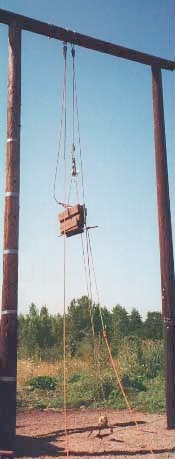RIGGING - DROP TOWER TESTS
Rigging Home >> Drop Tests >> Drop Tower TestingThe support structure for the drop tests consists of wooden power-pole uprights supporting a crossbar -- similar to the Greek letter Pi.
The crossbar is 25 feet (a bit over 7 meters) above the ground and about 10-12 feet (3-4 meters) long. Around the crossbar, three sections of wire rope are wrapped and swaged to form three loops to be used as anchors. Another section of wire rope is wrapped around a piece of pole which is buried in the ground with a bight extending above the soil surface. This ground loop is used as an anchor for change of direction pulleys on the lifting line (used to raise the load) and the release line (which releases the load from the lifting line).
The main anchor on the crossbar supports the "unit under test" and is subjected to the shock load of the drop. The lifting line goes from the load up through a pulley attached to an anchor on the crossbar, down through a directional pulley fastened to the ground loop, and to the PTO winch on the CMRU truck.
The load consists of sections of railroad rail about 2 feet long. This length results in a weight of about 30 kilograms per section. The rail sections have a hole cut in their web near each end, which allows the sections to be cabled together and lifted as a unit.
For these tests, loads of 210 kg and 300 kg are used to approximate the weight of a loaded litter with one or two litter attendants.
